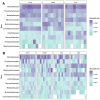Body site microbiota of Magellanic and king penguins inhabiting the Strait of Magellan follow species-specific patterns
- PMID: 37933257
- PMCID: PMC10625763
- DOI: 10.7717/peerj.16290
Body site microbiota of Magellanic and king penguins inhabiting the Strait of Magellan follow species-specific patterns
Abstract
Animal hosts live in continuous interaction with bacterial partners, yet we still lack a clear understanding of the ecological drivers of animal-associated bacteria, particularly in seabirds. Here, we investigated the effect of body site in the structure and diversity of bacterial communities of two seabirds in the Strait of Magellan: the Magellanic penguin (Spheniscus magellanicus) and the king penguin (Aptenodytes patagonicus). We used 16S rRNA gene sequencing to profile bacterial communities associated with body sites (chest, back, foot) of both penguins and the nest soil of Magellanic penguin. Taxonomic composition showed that Moraxellaceae family (specifically Psychrobacter) had the highest relative abundance across body sites in both penguin species, whereas Micrococacceae had the highest relative abundance in nest soil. We were able to detect a bacterial core among 90% of all samples, which consisted of Clostridium sensu stricto and Micrococcacea taxa. Further, the king penguin had its own bacterial core across its body sites, where Psychrobacter and Corynebacterium were the most prevalent taxa. Microbial alpha diversity across penguin body sites was similar in most comparisons, yet we found subtle differences between foot and chest body sites of king penguins. Body site microbiota composition differed across king penguin body sites, whereas it remained similar across Magellanic penguin body sites. Interestingly, all Magellanic penguin body site microbiota composition differed from nest soil microbiota. Finally, bacterial abundance in penguin body sites fit well under a neutral community model, particularly in the king penguin, highlighting the role of stochastic process and ecological drift in microbiota assembly of penguin body sites. Our results represent the first report of body site bacterial communities in seabirds specialized in subaquatic foraging. Thus, we believe it represents useful baseline information that could serve for long-term comparisons that use marine host microbiota to survey ocean health.
Keywords: Clostridum sensu stricto; Ecological drift; Marine host microbiome; Marine sentinel microbiome; Metabarcoding; Microbial ecology; Psychrobacter; Seabird microbiota.
©2023 Ochoa-Sánchez et al.
Conflict of interest statement
Luis E. Eguiarte and Valeria Souza are Academic Editors for PeerJ.
Figures








Similar articles
-
The ephemeral microbiota: Ecological context and environmental variability drive the body surface microbiota composition of Magellanic penguins across subantarctic breeding colonies.Mol Ecol. 2024 Sep;33(17):e17472. doi: 10.1111/mec.17472. Epub 2024 Jul 30. Mol Ecol. 2024. PMID: 39077982
-
Faecal microbiota changes associated with the moult fast in chinstrap and gentoo penguins.PLoS One. 2019 May 8;14(5):e0216565. doi: 10.1371/journal.pone.0216565. eCollection 2019. PLoS One. 2019. PMID: 31067284 Free PMC article.
-
Enterococci from Wild Magellanic Penguins (Spheniscus magellanicus) as an Indicator of Marine Ecosystem Health and Human Impact.Appl Environ Microbiol. 2020 Sep 17;86(19):e01662-20. doi: 10.1128/AEM.01662-20. Print 2020 Sep 17. Appl Environ Microbiol. 2020. PMID: 32737129 Free PMC article.
-
Current knowledge of the Southern Hemisphere marine microbiome in eukaryotic hosts and the Strait of Magellan surface microbiome project.PeerJ. 2023 Oct 3;11:e15978. doi: 10.7717/peerj.15978. eCollection 2023. PeerJ. 2023. PMID: 37810788 Free PMC article. Review.
-
Factors in the decline of the African penguin: Are contaminants of emerging concern (CECs) a potential new age stressor?Mar Pollut Bull. 2024 Sep;206:116688. doi: 10.1016/j.marpolbul.2024.116688. Epub 2024 Jul 18. Mar Pollut Bull. 2024. PMID: 39029148 Review.
Cited by
-
Daily turnover of airborne bacterial communities in the sub-Antarctic.Environ Microbiome. 2025 Jul 18;20(1):91. doi: 10.1186/s40793-025-00745-y. Environ Microbiome. 2025. PMID: 40682122 Free PMC article.
References
-
- Alizadeh-Birjandi E, Tavakoli-Dastjerdi F, Leger JS, Faull KF, Davis SH, Rothstein JP, Kavehpour HP. Delay of ice formation on penguin feathers. The European Physical Journal Special Topics. 2020;229:1881–1896. doi: 10.1140/epjst/e2020-900273-x. - DOI
-
- Anderson MJ, Walsh DCI. What null hypothesis are you testing? PERMANOVA, ANOSIM and the Mantel test in the face of heterogeneous dispersions. Ecological Monographs. 2013;83:557–574. doi: 10.1890/12-2010.1. - DOI
-
- Banks JC, Craig Cary S, Hogg ID. Isolated faecal bacterial communities found for Weddell seals Leptonychotes weddellii, at White Island, McMurdo Sound, Antarctica. Polar Biology. 2014;37:1857–1864. doi: 10.1007/s00300-014-1567-x. - DOI
MeSH terms
Substances
LinkOut - more resources
Full Text Sources

